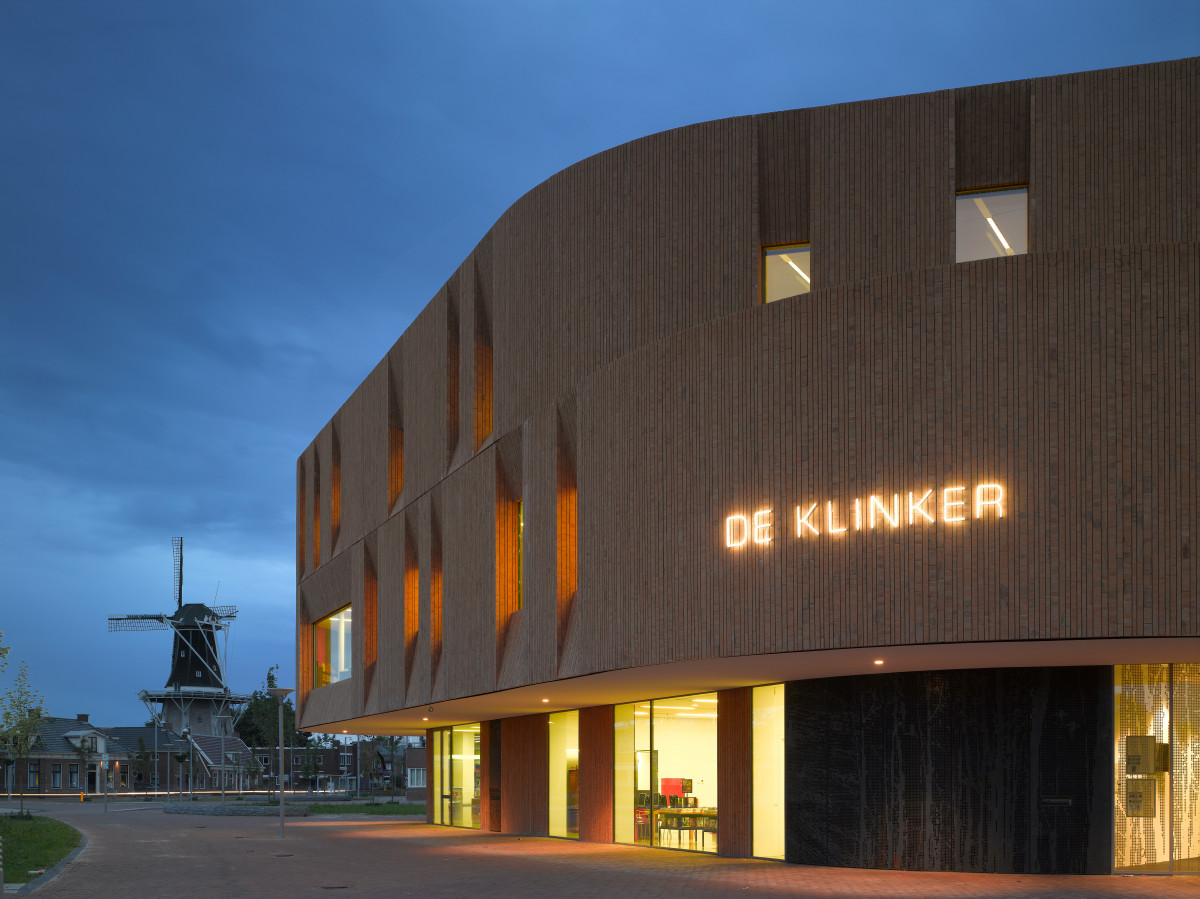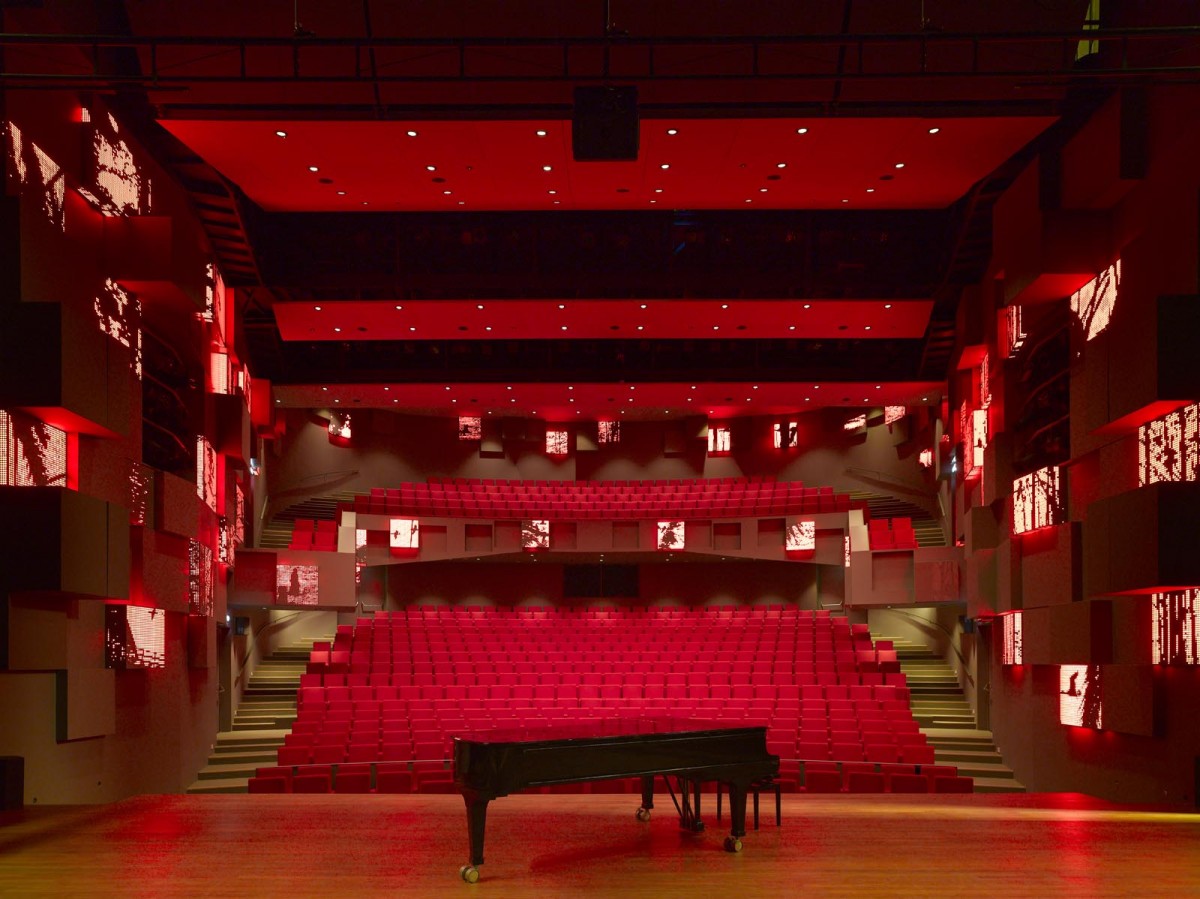The Klinker Cultural Centre was given a lively exterior to reflect the expressive nature of its programs. Its central location in Winschoten makes it easily accessible to the residents who can enjoy the cultural offerings of the theatre, arts centre, radio studio and library, or savour a coffee in the theatre café. In this way, residents themselves actively contribute to their city’s cultural life.
Cultural icon in Groningen region
The striking carved exterior of the centre is designed without front or back facades in order to better engage its surroundings on all sides. This also maximises and accentuates its footprint on the site, while the gentle angles of the continuous facade play with the laws of perspective and shorten visual distances. The horizontal sections, curved edges and overhangs recall 1920s Expressionist architecture in Groningen. The building anchors itself in Winschoten by echoing the morphology of its surroundings. It functions as a juncture between the small-scale buildings of the historic inner city and the larger scale of post-war developments and renovations. The adjacent city centre is characterised by double-storey masonry houses made of local Groningen clay. The reduced scale is emphasized by the horizontal bands that split and join as they move around the building. Major characteristics of the building are its richly detailed vertical masonry and deep, sloping window recesses which lend the building a strong and bold appearance. Different types of bricks were specially designed for the project and produced in traditional orange Groningen clay. The technical zones in the plinth also reflect a connection to the surroundings. The raw, brown/orange ends of the building feature CorTen steel surfaces perforated with the contours of Groningen’s landscape.
The foyer, Winschoten’s public domain
The foyer is the heart of the building, where the audience can meet one another and have post-show discussions. The space is animated by the dynamic positioning of the theatre in the building, especially with the warm glow of daylight bouncing on the wood surfaces throughout the day. The rounded form of the theatre is the first sight when entering the foyer. Its volume is disconnected from the floors and is emphasised further by the lofty void surrounding it.
At night, the atmosphere in the foyer is determined by the intensity of the colour of the lighting. This enables the mood of the space to be easily adapted for different events, from classical performances to pop concerts.
Multipurpose function
Besides its public purpose, the foyer connects all the functions within the Cultural Centre. It can also host various other activities including book markets, receptions etc. During the day, the library can use it to display books or extend the reading area beside the theatre café. At night, the foyer is entirely taken over by the theatre. The stairs to the upper floors are strategically positioned and are designed in order to separate the flow of traffic into public and private sections. The spacious public staircase is located inside the foyer, while the private stairs are incorporated into the volume itself.
The central positioning of the theatre forms a natural division between the public and private zones. Backstage functions are grouped around the stages of the two theatres. The loading zone is designed with a simple screen that ensures privacy for the artists and technicians. Offices are also connected to the backstage zone. The goods lift is accessible externally and from the loading zone.
Acoustics
The Cultural Centre has an innovative acoustic design developed by atelier PRO in conjunction with building physics consultant Peutz (Groningen). The multipurpose studio, music school, dance studio and the two theatres can all be used simultaneously without audible interference. The dilatations around the theatres ensure acoustic separation of the performance spaces. In this way, a film can be shown in the black box theatre while a chamber orchestra performs in the main theatre. Additionally, music rooms are placed on the second floor using a box-in-a-box approach. This allows different types of users, from pop bands to music ensembles and percussion groups, to rehearse simultaneously without disturbing each other or the silent atmosphere of the library.
Auditorium theatre and black box theatre
In this theatre, performers have the possibility to come very close to the audience, creating an intimate atmosphere. Furthermore, by closing off the orchestra pit using a sliding floor panel, the stage can be extended towards the auditorium. The auditorium contains 650 seats spread over the parterre and balcony with loges.
The seats and theatre drapes are dark red, while the walls are dark grey and covered with acoustic elements for sound diffusion, reflection and absorption. These elements also contain adjustable mood lighting.
Sound amplification is not necessary thanks to acoustic reflectors placed above the proscenium. If reflectors are not needed, they can be raised into the flyloft, and performers can come even closer to the audience. While the auditorium is characterised by classic theatre colours, the black box theatre has a completely different atmosphere with exposed concrete walls and blue acoustic elements. The circular curtain helps regulate acoustics further. This space is ideal for diverse performances from chamber music to theatre or cinema, while also suitable for conferences and receptions. The large window at the back of the theatre offers a panoramic view of Winschoten.
The design covers both architecture and interior design.
Publications
Baksteen # 69 2017
Brick buildings volume 1
Video van de bibliotheek van Winschoten
Bibliotheek in Cultuurhuis de Klinker van Winschoten in de top 3 van Nederland
What's the opinion of the client and how is the user experience? Read more.

















